Moultons, Modern and Vintage
Local bike shop Harris Cyclery has begun carrying Moulton bicycles, and I had not seen one up close until now. They had a dove gray one in the window that called out to me, so I took it outside for a closer examination and test ride. Jon Harris then brought out another Moulton - one of his personal bikes made in the 1960s, that had once belonged to Sheldon Brown. It was informative to see the two models side by side.
The new Moulton is the TSR 9 model, manufactured by Pashley-Moulton.
Moulton bicycles have a complicated history. Production initially began in 1962, then ceased in the 1970s and resumed in the 1990s - with some models produced under license by Pashley.
This bicycle has a Moulton headbadge on the head tube and a Pashley headbadge on the seat tube.
The frame design is called a space frame, and it allows for greater rigidity and lighter weight in comparison to traditional steel frames.
Moultons are not folding bicycles, but are "separable" and can be disassembled for travel.
In addition to their unique geometry and small wheels, Moultons are distinguishable by their suspension system - which they had originally implemented decades before it would become common.
Components on the Pashley-Moulton models are modern and off-the-shelf, which keeps the price "reasonable" (this one is just over $2,000) compared to the higher-end models.
My impression of the space-frame Moulton is somewhat confused. I find it architecturally interesting and beautifully constructed. However, I do not quite understand what makes it a good bicycle. I mean, is one expected to buy it because it is unusual looking and has a cool history, or does it have unique characteristics that make it superior to other bicycles? By moderns standards, it is not a lightweight bike by any means (26 lb without pedals), which somewhat defeats the small wheel construction. And the complicated frame structure - while beautiful to look at - makes me worry that I'll get my foot stuck somewhere in there while attempting to step over it. It just doesn't seem like a very practical design to me. Also, to my eye the handlebar set-up on this model clashes with the frame, and it seems to me that some effort could have been made to keep the price down while finding more elegant components.
I tried to ride the bicycle, but the front suspension felt so powerful that I did not feel comfortable test riding it in the winter. The Co-Habitant rode it briefly and did not feel stable on it, which may have to do with the suspension as well - neither of us is used to it. The conditions on this day were not ideal for properly test riding bikes, so I'd like to try it again when it gets warmer. But on first impression, the Moulton space frame bike did not feel entirely welcoming.
On the other hand, I was surprised by how friendly and accessible the vintage "F-frame" model felt in comparison. This is one of the original models, introduced in the early 1960s - the Major Deluxe. It came with a 4-speed hub, front and rear rack, and a large bag mounted on the rear. Here is a neat promotional video from when these bikes first came out.
Despite being somewhat heavier than the currently produced space-frame, I found the vintage f-frame easier to lift and carry.
The step-over is considerably lower as well. In other ways too, the vintage Moulton just felt like a better fit for my proportions; it felt very natural.
And of course the classic components are absolutely charming.
The North-roadish handlebars are more comfortable than the straight bars on the modern production bikes.
The fenders and racks are extremely useful, and the bag is huge. In essence, it is a small, practical bike - not as visually striking as the later space-frame, but more user-friendly.
I appreciated the opportunity to have a closer look at the Moultons, and would like to properly test ride the modern production bicycle once Spring arrives. While I can see myself owning and riding the vintage F-frame model, I find the newer space-frame model intimidating and somewhat impractical, though visually compelling. Moulton owners and enthusiasts are welcome to contribute their impressions.
The new Moulton is the TSR 9 model, manufactured by Pashley-Moulton.
Moulton bicycles have a complicated history. Production initially began in 1962, then ceased in the 1970s and resumed in the 1990s - with some models produced under license by Pashley.
This bicycle has a Moulton headbadge on the head tube and a Pashley headbadge on the seat tube.
The frame design is called a space frame, and it allows for greater rigidity and lighter weight in comparison to traditional steel frames.
Moultons are not folding bicycles, but are "separable" and can be disassembled for travel.
In addition to their unique geometry and small wheels, Moultons are distinguishable by their suspension system - which they had originally implemented decades before it would become common.
Components on the Pashley-Moulton models are modern and off-the-shelf, which keeps the price "reasonable" (this one is just over $2,000) compared to the higher-end models.
My impression of the space-frame Moulton is somewhat confused. I find it architecturally interesting and beautifully constructed. However, I do not quite understand what makes it a good bicycle. I mean, is one expected to buy it because it is unusual looking and has a cool history, or does it have unique characteristics that make it superior to other bicycles? By moderns standards, it is not a lightweight bike by any means (26 lb without pedals), which somewhat defeats the small wheel construction. And the complicated frame structure - while beautiful to look at - makes me worry that I'll get my foot stuck somewhere in there while attempting to step over it. It just doesn't seem like a very practical design to me. Also, to my eye the handlebar set-up on this model clashes with the frame, and it seems to me that some effort could have been made to keep the price down while finding more elegant components.
I tried to ride the bicycle, but the front suspension felt so powerful that I did not feel comfortable test riding it in the winter. The Co-Habitant rode it briefly and did not feel stable on it, which may have to do with the suspension as well - neither of us is used to it. The conditions on this day were not ideal for properly test riding bikes, so I'd like to try it again when it gets warmer. But on first impression, the Moulton space frame bike did not feel entirely welcoming.
On the other hand, I was surprised by how friendly and accessible the vintage "F-frame" model felt in comparison. This is one of the original models, introduced in the early 1960s - the Major Deluxe. It came with a 4-speed hub, front and rear rack, and a large bag mounted on the rear. Here is a neat promotional video from when these bikes first came out.
Despite being somewhat heavier than the currently produced space-frame, I found the vintage f-frame easier to lift and carry.
The step-over is considerably lower as well. In other ways too, the vintage Moulton just felt like a better fit for my proportions; it felt very natural.
And of course the classic components are absolutely charming.
The North-roadish handlebars are more comfortable than the straight bars on the modern production bikes.
The fenders and racks are extremely useful, and the bag is huge. In essence, it is a small, practical bike - not as visually striking as the later space-frame, but more user-friendly.
I appreciated the opportunity to have a closer look at the Moultons, and would like to properly test ride the modern production bicycle once Spring arrives. While I can see myself owning and riding the vintage F-frame model, I find the newer space-frame model intimidating and somewhat impractical, though visually compelling. Moulton owners and enthusiasts are welcome to contribute their impressions.

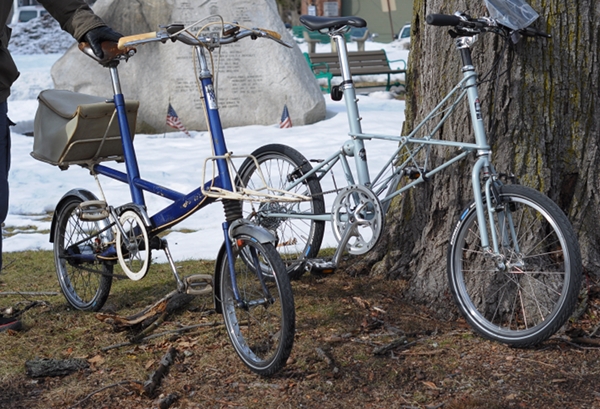
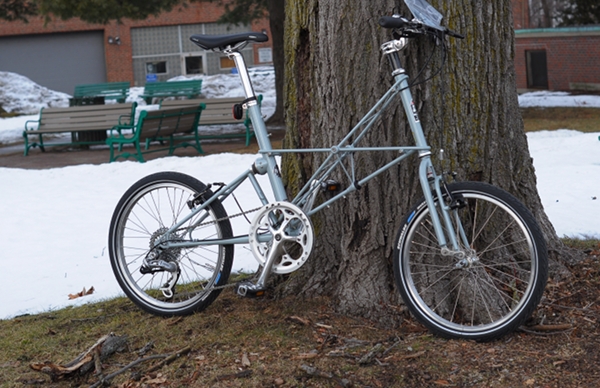

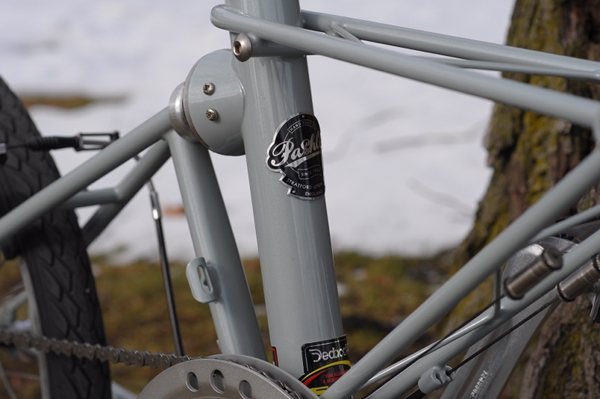
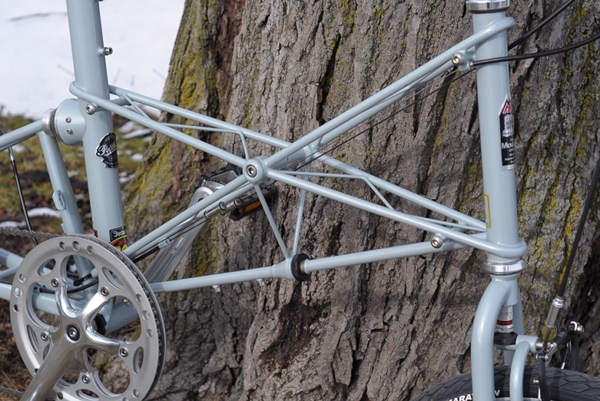
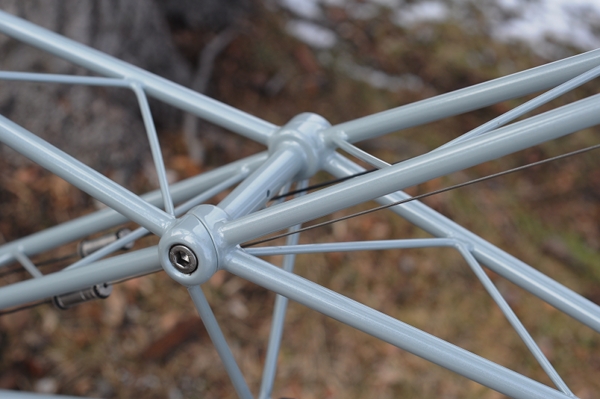
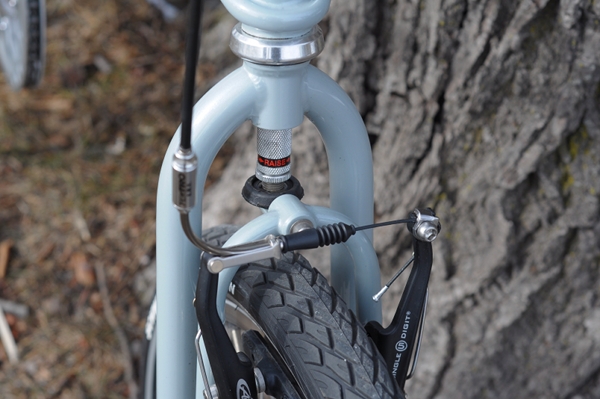
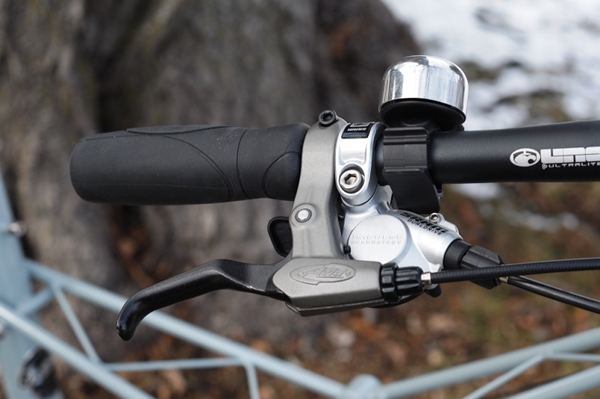

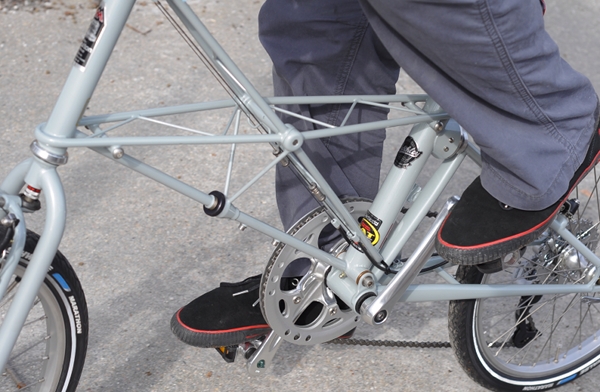
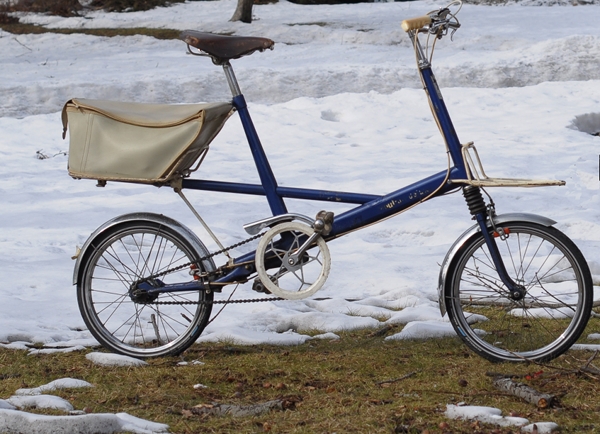
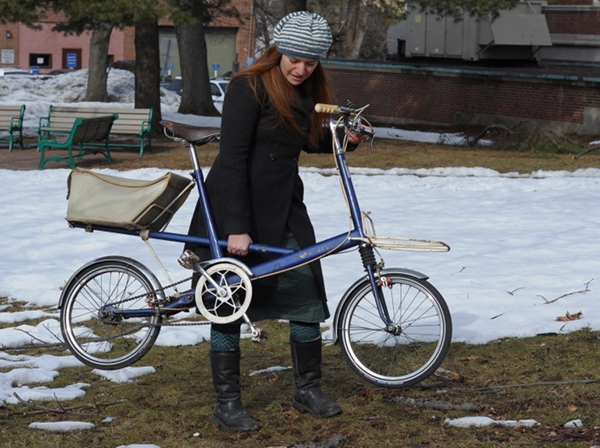
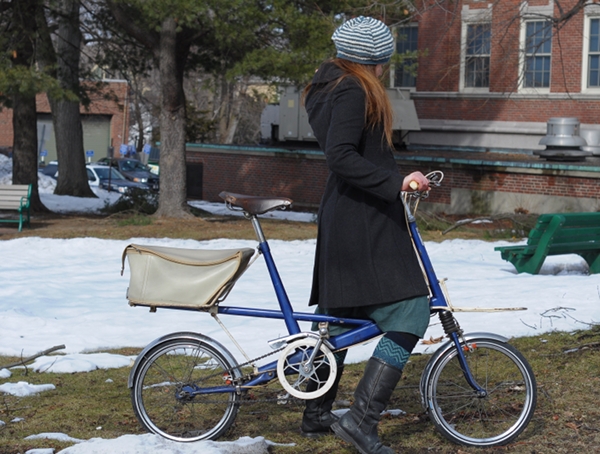

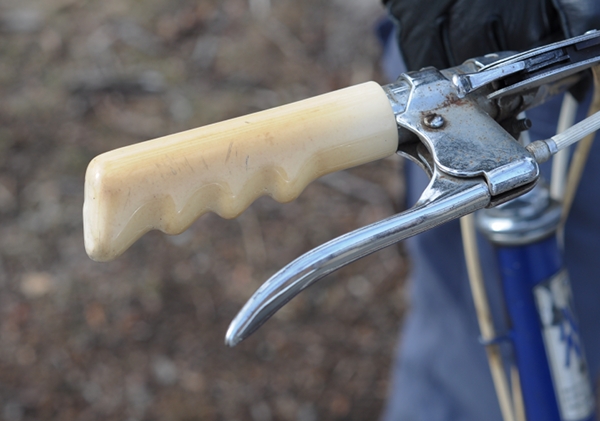

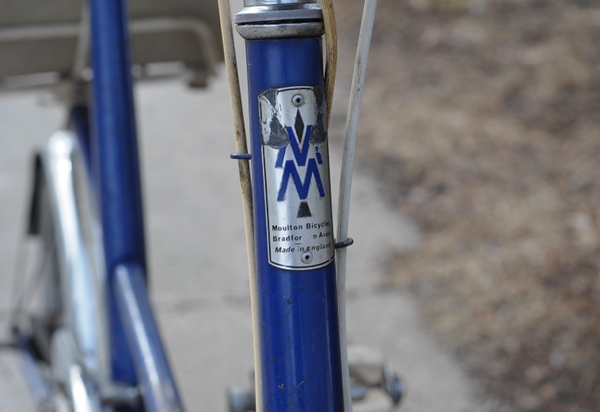
I've always enjoyed the look of the space frame, but as far as I can tell, they're really meant to be iconic collectors bicycles for the well heeled.
ReplyDeleteSomething like a Bike Friday or Brompton pretty much takes them out of the equation for most potential buyers.
I wonder if the front suspension is adjustable and maybe it was just too loose.
Jammy - I think the Pashley-Moulton models in the low-mid $2K range are actually meant to be useable. But it's true that for the price you could get a Brompton with full folding capability, choice of handlebars and colour, and dynamo lighting. As far as value for the money, it is difficult to not favour the Brompton - unless one makes the argument that the space frame and the suspension have advantages when it comes to ride quality.
ReplyDeleteI think the saddle was much too low for me. I wasn't intending to ride either of them, but it seems we just can't resist trying weird bikes whilst at Harris.
ReplyDeleteThe new Moulton did feel like it would turn its wheel to the side and throw me if I let go of the handlebar. I didn't have any issues riding either bike, nor did it feel somehow revolutionary or better than a regular bike, but I _think_ the older one felt perhaps a bit more stable. I do of course now want to go back there in the summer and try both of these against a Brompton (the bike I really want, actually) but this time properly adjusted.
wow, $2K plus! makes me wonder if the buyer of such a bike might have more money than sense.
ReplyDeleteAnon - Yes, but put it in context: In a market where cyclists have no problem dropping $5K+ on a carbon fiber roadbike, I think $2K for a unique design like this is a fair price, if the bike performs well.
ReplyDeleteI look forward to hearing both of your thoughts on the bike come warmer weather. I checked and the shock stiffness should be adjustable via a screw, maybe the shop can tighten it up.
ReplyDeleteI too am considering a Brompton this year, the incredible portability and handmade-ness are appealing.
Velouria said...
ReplyDelete" I find the newer space-frame model intimidating and somewhat impractical, though visually compelling."
No, the space frame is just to weird and non traditional to be appealing to me at all! :()
In fact the space frame strikes me as a love it or hate it with no middle ground. Sometimes engineering just gets strange.........
Forgot to mention something about the new Moulton.
ReplyDeleteSee those V-brakes? Combined with small wheels and... these stop like crazy. Grab the brake just a little too much and the fork will go through the whole suspension range and off you go.
This isn't a criticism per-se, just please keep this in mind when trying this bike.
"See those V-brakes? Combined with small wheels and... these stop like crazy. Grab the brake just a little too much and the fork will go through the whole suspension range and off you go."
ReplyDeleteWhoa! I can see lawyer written all over that after a rider has to panic stop and gets hurt as a result!!!!
I was going to write "but doesn't Brompton have the same brakes?," but then looked at one of my pictures and saw that it has side-pulls. I wonder what the reasoning behind Moulton's v-brake decision was if it is indeed so dangerous to have them.
ReplyDeleteHi Velouria,
ReplyDeleteI have two Moultons, a Pashley APB DD24 and my most recent an Esprit. The Esprit has 17" wheels and was bought direct from the Factory, last May.
Both my Moultons were bought by comments from forums and club members experience which was usually quite positive.
I strongly recommend you take a long test ride as only then will you realise just how comfortable these bicycles are.
The Esprit is a lovely bike to ride but I had an issue with the 17" wheel catching in a slot in a graten. I was thrown off and received cracked ribs and a badly cut up and bruised leg.
I have just bought a Pashley Guvnor which I am enjoying riding.
I also have an aluminium sports bike, as I thought I should buy a 'proper bike' as the Moultons seem to be looked on with some amusement.
Anything out of the ordinary and you aren't thought of as a cyclist, or so it seems.
"See those V-brakes? Combined with small wheels and... these stop like crazy. Grab the brake just a little too much and the fork will go through the whole suspension range and off you go."
ReplyDeleteSometimes bad engineering, sometimes cost selected the wrong part. What matters is that if Moulton doesn't fix that design flaw then they deserve the lawsuits they will surly face. In fact the dealer should refuse to sell any until the factory ok's the design to absolve the dealer from any liability.
I had a 1965 Moulton. After replacing the rims and brakes, and adding drop bars, it was insanely fast. I'm not sure how well the local roadies took to being smoked by a bike with a basket on the back.
ReplyDeleteBridgestone made some new versions of the F-frame Moulton a few years back. They were supposedly lovely, but priced for the collector.
Robert - Jeez, I am sorry to hear that! Wheels getting stuck in cracks and grates is one of my fears when roadcycling. The Esprit looks interesting, would be curious to try a Moulton with drop bars.
ReplyDeleteWalt - I am pretty sure that these models been in production for several years now, and I've not heard of any lawsuits. I'd like to hear what the owners who ride the bikes have to say - it could be fine.
scruss - In this 1960s promotional video, toward the end they claim that the drop bar bike can go 50mph.
ReplyDeleteI have a Moulton TSR 9, like the one in the photos, which I have used as my main transport for the last couple of years. It has a rear rack with integrated large bag, very similar in style to the old Moulton, which is very practical.
ReplyDeleteNever had any issue with the linear-pull brakes. The TSR 9 has the more off-road version of the frame, hence the v-brakes, and there is a more road-orientated version that takes calipers.
The steering does feel light after riding a large wheeled bike, but I soon got used to it, and although the front end feels more unstable than a standard bike, the flipside is that it is a more manoeuverable, which I find useful in town.
The space frame makes the bike very rigid laterally, and coupled with the suspension that irons out most irregularities, the bike feels really solid going at speed over rough country roads. It is real joy on steep sweeping descents in a way that I can't really describe - the suspension compresses going into the bends in a way that feels really satisfying.
I do worry about the long-term durability of the frame though - some of the secondary tubing is very delicate, and has been knocked in bike racks.
I have long carried a torch for Moulton bicycles, but not for the sans suspension Raleigh version that substituted for the genuine article. It was very interesting and I hadn't seen the video before.
ReplyDeleteSee those V-brakes? Combined with small wheels and... these stop like crazy. Grab the brake just a little too much and the fork will go through the whole suspension range and off you go.
ReplyDeleteWelcome to the world of V-brakes: crazy power, poor modulation. I had the same initial impression with my Bike Friday. However, it's not particular to small wheeled bikes. V-brakes feel this way on bikes of all different size wheels. Eventually you adjust to it, but V-brakes just don't have the same modulation that cantilever brakes do.
I owned a Brompton for a while and it does have a great, small fold. But for anything over 5 or 10 miles, I just could not get used to those small wheels. I found the bike uncomfortable and thought it took considerably more energy to propel than my large wheeled bike. Because of this, it didn't get enough use to justify keeping it. It has it's place, but not in my current situation. Proprietary parts and mediocre braking and the strange 2x3 gearing setup were also not to my liking. Fortunately, it sold quickly and the loss was minimal, so no regrets.
ReplyDeleteI've admired the Moulton ever since the early 70s when my brother brought home the first Whole Earth Catalogue, which had an extensive writeup. The Moulton's suspension, which uses elastomers as springs, was revolutionary when it was introduced. That elastomer technology was put to use in some mountain bikes a dozen years ago but MTB technology has embraced different suspension systems.
ReplyDeleteI'm eager to read your reviews.
The Moultons, old and new, are such cool looking bikes. They come up on ebay periodically, but so far I've resisted the temptation to bid.
I owned a Brompton for a while and it does have a great, small fold. But for anything over 5 or 10 miles, I just could not get used to those small wheels. I found the bike uncomfortable and thought it took considerably more energy to propel than my large wheeled bike. Because of this, it didn't get enough use to justify keeping it. It has it's place, but not in my current situation. Proprietary parts and mediocre braking and the strange 2x3 gearing setup were also not to my liking.
ReplyDeleteBromptons are known more for their ability to fold and be toted on trains than for their performance as long distance bikes. It has nothing to do with the small wheels, as there are plenty of people who tour the world on small-wheeled bikes.
I wonder what the reasoning behind Moulton's v-brake decision was if it is indeed so dangerous to have them.
ReplyDeleteI wouldn't go so far as to call B-brakes dangerous! But they do take getting used to because it takes very little effort to lock up a wheel with a V-brake. And, they work best when paired with matched V-brake levers, which have greater cable pull.
I don't know exactly why the bike industry has adopted V-brakes so thoroughly, given that they aren't as easy to modulate as cantilever or sidepull brakes. They are unbelievably inexpensive compared to decent sidepulls or cantilever brakes (new Tektro V-brakes cost $20 for a complete front and rear set; Tektro cantis cost $60!) . I don't understand how any part of their design would make them cheaper to manufacture than other types of brakes, so maybe it is just a matter of economics of scale that make them so cheap. There are easily more V-brakes spec'd on new bikes than all other types of brakes combined.
hmm...i have seen moultons but not ridden one. the instability, i suspect, is due to the insufficient amount of 'trail' due to the small wheel diameter. anyone else sees the same thing? they'd have to reverse the fork rake to get more trail. it's like a toy bike to ride indoor.
ReplyDeletetrail:
ReplyDeletehttp://www.dclxvi.org/chunk/tech/trail/
Richard Ballantine raves about the Moulton in his 21st Century Bicycle Book ("Many people will tell you that the Moulton is the finest bicycle in the world. They have a good case.") He makes an elaborate argument based on suspension, lightness, rigidity, and carrying capacity, but I have never completely understood the appeal. I have a Brompton myself and am a big fan.
ReplyDeleteI think that if you spent a lot of time on the space frame bike you might find it more rigid. That is the big plus to space frame construction. You get to spread the forces out in all directions and take advantage of all sorts of beneficial geometry and triangulation. Look at the space frame in comparison to the F-Frame bike, the frame expands vertically, horizontally and triangulates between the tubes in all directions. A properly designed space frame in an airplane, racecar, motorcycle or whatever, compared to a structure of the of the same weight made of fewer members will always be more rigid(and can sustain a failure of one member without immediate catastrophic failure as in a single member structure). That's why the space frame on my home-made Lotus 7 replica weighs less and is more rigid than the Model A Ford type ladder frame on my Jalopy hot-rod. A monocoque structure can be lighter and more rigid yet, think big hollow crabon fiber. I just dont have the skill or equipment to build that sort of thing. Plus they tend to be sorta' unattractive to a mid/late 20th century guy like me.
ReplyDeletePlease lets not start describing various brake configurations as being easy or difficult to modulate based on un-instrumented tests of groups smaller than, say, 1000 examples.
One of the reasons cantilevers can be so nicely modulated is that by varying the length of the straddle cable, you can adjust the mechanical advantage of the brake, but like every dang thing, there is a compromise to be made, Short straddle cable, lots of potential power but high effort, long straddle cable(I've seen them all the way from the canti arms to just below the stem or the rear cable hanger)nice low effort and infinite modulation, but you can run out of lever travel merely from pad wear. How many people bother to tune the modulation on cantilevers (or centerpulls, they work to the same principles)... One of the reasons there are so many Linear Pull Brakes(V brakes) on new bikes is you get to eliminate the hangers and the brakes can be installed without having to thread cables through anything but the noodle. Modulation is one of those things you can tune so easily if you take the time. Your V-Brake not providing enough modulation? If you are willing to give up some ultimate power(and they typically have way more than necessary), try an old style cable with a little compressability built in(Hhmmm, like the cables on old cantilever brakes that modulate so well?). Modulation, to a large degree, is a function of some forgiving flex in the system.
This was going to be a little fifty word post and jeez, look what it turned into. 2000 words of self-indulgent gassing. Sorry...
Spindizzy
Warren, while it is true that reducing wheel diameter while keeping all other geometry variables equal will result in less trail, I doubt that's the Moulton's problem. I'm sure the designers took trail into account. Neither of the Moulton's shown above appear to have a lot of rake, so it's hard to say what kind of trail these bikes have.
ReplyDeleteBesides, some people claim that low trail makes for a very stable ride, especially when carrying a front load; others claim it can feel "twitchy" when unloaded. It seems to be a preference as opposed to a rule.
My Bike Friday tandem has 20" wheels and generally low trail (somewhere in the 30s) and was designed to handle a front load, but it feels perfectly stable without a front load.
hmm...all these comments on brake modulation...this has more to do, again, with the small diameter wheel: having the end of the fork closer to the ground makes for a longer lever arm to rotate and pitch the rider forward when braking is applied.
ReplyDeleteWhen Alex Moulton came out with his bicycles in the early '60's, he promoted them by getting racers to break records on them. Moulton claimed that the smaller wheels had much to do with the speed of those bikes. To this day, there are some who claim that smaller-wheeled bikes are faster for a number of reasons, including aerodynamics.
ReplyDeleteI won't support or refute any of his claims. However, I should point out that the records that were broken were ones for particular courses and routes. Some of those records had not been challenged for decades before the racers on the Moultons broke them.
That said, I'd buy an older Moulton if the price were right. While I like the look of the new one (It makes me think of a bridge.), I don't find it compelling, at least not as a bike.
Bicycle Quarterly reviewed a Moulton bike in the Autumn 2010 issue, and also discussed the history and rationale of the design. I think anyone considering buying a Moulton would find that issue interesting reading, although the company was clearly unhappy with the conclusions reached in the review.
ReplyDeleteI tend to think of Moultons the way I think of Robin Reliants, those ridiculous geeky three-wheeled cars (I don't think you have them in the States); I just look at them and ask: Why?
ReplyDeleteBack in 1985 when I was the director of a museum in northern Sweden I made a summer exhibition on cycles using our hall of some 1200 square feet. Not about how nice it was to ride, but about different kinds of bicycles and the interaction of bicycle and man. We showed touring bikes, utility bikes, racing bikes and different kinds of paraphernalia as bars and derailers and talked about how they worked. Among the exhibits was a high-wheeler, a Svea bike from 1901, a Dursley-Pedersen, a Roulandt recumbent, a Leitra and of course also a new space-frame Moulton.
ReplyDeleteNaturally, I tried all those bikes!
My own daily ride and base compare at the time was Old C, then quite young, a Centurion Super Tour from 1982 with a trail of 40 mm.
I used the Moulton on good roads and bad roads at home in Örnsköldsvik and not so little on asphalt and stone streets in Stockholm. On decent roads I could emulate the ride of Old C quite well. As good, but not better. The drawbacks were two: On bad roads the small wheels could not take irregularities as well. The suspension helped but some holes were simply the wrong size for small wheels to float over.In town the need to brake often was a problem. You can adjust the suspension, but either it was so hard as give no pleasure on the streets or so soft that the bike nose-dived when braking which I found unpleasant.
I think modern tires like the Hetres gives the same comfort without the disadvantages. I can see a couple of advantages though, the first being the possibility to quickly adjust it to different family members, the second it´s stowability. If these are important to you the Moulton is definitely better than an unsuspended small-wheeler, but I doubt that the space-frame is really a step forward from the original.
@summervillian -
ReplyDeleteBromptons are known more for their ability to fold and be toted on trains than for their performance as long distance bikes. It has nothing to do with the small wheels, as there are plenty of people who tour the world on small-wheeled bikes.
I am aware that people use small wheeled bikes for touring and have a friend who really has
'toured the world' on a Bike Friday with 20" wheels. But I do think the 16" wheel is inferior to a larger wheel in terms of comfort and ease of covering distances. I hear a lot of 'Brompton lust' in forums and wanted to temper it with my experience. As a multi-model travel aid over smoother roads, they are great, and some have used them for greater distances. But for me the bike is very specific, too niche, slow and uncomfortable.
I owned a Brompton for a while and it does have a great, small fold. But for anything over 5 or 10 miles, I just could not get used to those small wheels. I found the bike uncomfortable and thought it took considerably more energy to propel than my large wheeled bike. Because of this, it didn't get enough use to justify keeping it. It has it's place, but not in my current situation. Proprietary parts and mediocre braking and the strange 2x3 gearing setup were also not to my liking.
ReplyDeleteI find my Brompton is great, even over longer distances. I find the small wheels take less energy to get up to speed than my larger-wheeled bikes, although they are more sensitive to the surface you are riding on. I find that the ability to fold it up and take it on any other form of transport makes me more ambitious with it; I know I'm not completely stuffed if something goes wrong with me or the bike whilst I'm far from home because I can always fold it and hop on a bus/train etc. I rode 20 miles to work this morning on mine and it was a pleasant enough experience too.
Warren, I think the tendency for small wheel bikes to want to pitch you off when you brake too hard is due to other things, like the center of gravity being so far above the axle(the fulcrum you pivot over on your way to that face-plant), the fact that these bikes tend to have such short wheelbases that place your weight that much closer to that front axle and other factors.
ReplyDeleteThe short distance between the axle and the brake shoes actually increases your body weights mechanical advantage to resist the forces that try to lever you off the bike. If you want to experience the opposite effect, ride a Penny-Farthing a little. The ability for the long lever created between the axle and the pathetically feeble spoon brake is more than the enough to overcome the little leverage your body has at it's disposal to resist it's diabolical plan to leave a negative impression of your face in the dirt.
You're right that some small wheel bikes have weird brake characteristics but super power isn't the root cause. The larger the wheel diameter the more leverage the brake has, that's why us fat guys put larger diameter discs on our mountainbikes to increase braking power.
Spindizzy
I have three bicycles: a Brompton, a Giant 'Expression' hybrid/commuter with straight bars, upright position, hub gears & brakes, and a Mercian 'Triathlon' Audax style lightweight tourer with drop bars. The Brompton has 16" wheels, the others 700C. As regards steering, I notice that if I try to wheel each along using just a hand on the saddle, walking next to the bike, one steers easily and responsively just by leaning the bike a bit, one is difficult to deviate from a straight line, and one always falls over (well, almost always)
ReplyDeleteNow, which do you think is which?
This comment has been removed by the author.
ReplyDeletePlease lets not start describing various brake configurations as being easy or difficult to modulate based on un-instrumented tests of groups smaller than, say, 1000 examples.
ReplyDeleteWell then, why don't we extend that suggestion to all aspects of the cycling experience... larger sample size would surely make all our anecdotal input more meaningful. Maybe once we get 1000 examples of direct comparisons between various Brooks saddles, or flat resistance between different tires, then these comments can all take on a new, more authoritative meaning. I guess until then, all these comments are purely worthless and... as you put it, gassing.
Justine Valinotti said...
ReplyDelete"While I like the look of the new one (It makes me think of a bridge.), I don't find it compelling, at least not as a bike."
Maybe that's what's disconcerting to me as well - I like the look of the frame, just perhaps not necessarily on a bike : )
Re the comparisons to Brompton - my first impressions of the two were nothing alike. If anything, the new Moutlon felt more like the D2R Boogie but with suspension, and the vintage f-frame felt a bit like the Raleigh Twenty.
I like to wipe down my bikes whenever I clean and re-lube the chain: about once every week or two; or any day it's wet. (Same ethic as a horse; never ride 'em hard and put 'em away wet.) Wiping down that space frame seems like it would be a *pain*.
ReplyDeleteLateral stability on a *Bicycle*? Um, how much side force do you ever put on a bike? Wrestling it in and out of a comb bike stand is more side force than I ever put on it while riding, therefore I don't consider it contributing to ride quality.
Somervilian, Yeah, That did come out sounding dumb. I hope nobody took that personally cuz' it wasn't meant that way.
ReplyDeleteDo you agree that sometimes the conventional wisdom about some of these things needs to be questioned though? I think this is one of those situations where the "word on the street" contains some truth but it's hidden under a layer of unscientific "fact" that is mis-leading and prevents real understanding.
There are real advantages and disadvantages to all the various types of bike brakes but they are all just variations of the same simple mechanism. Even the hydraulic versions use roughly the same ratios of mechanical advantage and they ALL have similar potentials. U-Brakes, V-Brakes, cantilevers, centerpulls and on and on can all be made to apply the same amount of force and if you make them strong enough and take the trouble to build in the characteristics you want they will all perform about the same.
I think I can back all this up if you want me to and I promise to try not to sound like such a jerk...
Spindizzy
I don't get this smaller wheels easier to spin thing. Yes, it's true that the rotational inertia in this case is hugely dependent on the radius, and so on, but...
ReplyDeleteHas anyone tried to spin a wheel off the ground? With a flick of the wrist, holding a single pedal, you can bring it to a million miles an hour so that the bike feels like it will vibrate apart (crappy wheels?). Anyway, it doesn't take much effort to spin a wheel. I think all the riding effort goes into overcoming the inertia of the rider, carrying mass up a hill or working against the wind, or lost to rolling friction. Maybe there's a slight aerodynamic advantage to small wheels, but come on. Spinning the wheels is so far down the list that it's negligible, whether they are 28" or 16".
MDI-- tell that to all the roadies I blow away at stop lights on my 20" wheeled Bike Friday tandem-- without the help of a stoker. It's true, I can "jump the line" faster than most of the hardcore commuters who crowd around at the stoplights and righteously expect to be the first off the line when the light turns. Most of them are surprised.
ReplyDeleteIn reality, I don't know how much of a difference there is, and it might not be much, but there is a difference that can I can feel.
Also, Jan Heine recently did a report on the gyroscopic effects of different wheel sizes on bike stability, and according to him, smaller wheels definitely have less gyroscopic inertia than larger ones.
As far as I am concerned the Moultons are as good as anything out there. I have a Focus Ergoride with 700c wheels and 25mm tyres. This bike is a difference experience (though not as comfortable as either of my Moultons and transmits road shock whereas the Moultons lose this in their suspension) which I thoroughly enjoy.
ReplyDeleteMy newest bicycle, a Pashley Guvnor is again different, very relaxed with road shocks damped with the tyres and the frame/forks.
I am not narrow minded and would consider many bicycles as each have their own characteristics, each of them being a different riding experience.
The Moulton Esprit, once used with it, is a joy, although jumping on it just after the Guvnor may cause panic attacks for a short time. After that it's second nature.
I have owned a vintage F-frame
ReplyDeleteMoulton, the same model as the blue one
described here. I liked it
but could not see any real advantage
for me, especially as they do not fold.
But here is a bike I do like:
http://en.wikipedia.org/wiki/Birdy_(bicycle)
It may not look to everyones taste,
but they are comfortable to ride all
day long (my wife and I have completed
three 4-month-long camping tours
carrying four panniers each in Europe
and Africa)
and they fold as quickly as a Brompton
(but not quite as small).
Like every bike there are tradeoffs.
They do not ride as well out of
the saddle as I would like, they
are not as stable on fast downhills
either, but you can take them on
any bus, which widens our cycling
horizons without the need for a car.
We just got back to the UK
from a weekend cycling
in Belgium with them :)
John I
Velouria,
ReplyDeleteHere is a Moulton you may like:
http://www.jitensha.com/eng/moulton_e.html
It is based on the original F-frame
concept but with modern components.
I personally prefer the ride of this
bike compared to the spaceframe Moultons.
John I
One month in and I am growing very fond of my Cannondale Hooligan 8. It doesn't fold and I certainly do not want or need it to: I only have a 2.1 mile commute on fairly benign public roadways and it navigates the hallways and fits in my office. People ask me about it.
ReplyDeleteWe go huge grocery shopping every three months and use a Ford Explorer to do that. We grow vegetables and I'm building a greenhouse on our lot. We use all different kinds of bikes to do fill-in shopping, but we're not perfect.
johni said...
ReplyDelete"Here is a Moulton you may like:
http://www.jitensha.com/eng/moulton_e.html
It is based on the original F-frame
concept but with modern components."
Hmm... I prefer the vintage f-frame. The new Bridgestone version has aluminum tubing with a unicrown fork and bent chainstays for starters, and there must be other subtle differences as well that are making me like it less.
sipelgas said...
ReplyDelete"...I think modern tires like the Hetres gives the same [suspension] comfort without the disadvantages. "
I agree. There are a few tires, such as Grand Bois Hetres, Schwalbe Fat Franks, and even the narrower Schwalbe Delta Cruisers that are great at swallowing road shock.
My wife and I have been riding AM7 spaceframe Moultons built in 1985 for the past 15 years. I also commute on a 1965 Moulton Standard. These are absolutely wonderful bicycles. They carry luggage with integrated racks, they can go as fast as we need, they're nimble and smooth. They can accommodate riders from 5'2" to 6'7", men or women. Moultons can be modified and customized to meet any rider's needs. The suspension on our 25 year old bikes work wonderfully. I'd suggest that before jumping to conclusions based upon extremely limited exposure, folks spend some time with these wonderful machines. They are an absolute joy to own and ride. Aaron Shapiro, Portland, Maine
ReplyDeleteThe nubby little cylinder at the top end of the brake noodle (see picture 7) is there to do exactly what Spindizzy described: add compressibility to the cable housing in order to increase modulation by requiring a greater length of cable to be pulled in order to reach maximum clamping force. The drawback of this device (it's just a spring that gets compressed between the brake housing and the noodle) is that it reduces the already small amount of clearance between brake pad and rim.
ReplyDeleteAlso, suspension is there to aid in stability, not detract from it. Sipelgas, however, highlights a notable deficiency in many suspension designs: brake dive. It seems a shame that the space frame Moulton's leading link fork doesn't eliminate this issue; perhaps the application of a drum brake anchored to the linkage would solve the issue. Just an armchair speculation.
I owned a '73 Raleigh Moulton. It was fun and it was fast and mostly it was practical. The big insurmountable problem was that riding on bad roads - Chicago - there were bumps and potholes that simply defeated the suspension. When you slam that little wheel into the far side of a pothole the small radius tire makes a sharper angle of contact than would a big tire. Result was starburst failure in the tire casing. Over and over. The small tires are real easy to change, but it gets old fast buying tires and needing to carry both tire and tube on every ride.
ReplyDeleteWouldn't be so big a problem if you simply rode slow. Or if you lived in wonderland with paved roads.
A fun bike, glad I tried it, promising but flawed.
One other thing: You have to keep your weight back. You can set it up so pitching over the front wheel is no more an issue than on a standard bike. You can also set it up carelessly so that pitching is an ever present danger.
Spindizzy:
ReplyDeleteWarren, I think the tendency for small wheel bikes to want to pitch you off when you brake too hard is due to other things, like the center of gravity being so far above the axle(the fulcrum you pivot over on your way to that face-plant), the fact that these bikes tend to have such short wheelbases that place your weight that much closer to that front axle and other factors.
Not quite... Your analysis requires a reference frame that accelerates (the front axle moves at different rates over time in your gedankenexperiment). There isn't really any pivot point for the over-the-bars maneuver; the rider's center of mass describes an oval shape, not a circle. The only external forces acting on the bike/rider system are gravity and static friction between the road surface and the tire, so at any point in time there is a effective pivot point, but that point is not at the front axle -- it's where the tire contacts the road. The small wheel does make it easier to go over the bars, but that's because it doesn't cause the rider to go up as high as the large wheel, decreasing the amount of energy required. It's also likely that the contact point of the small wheel is closer to the rider on the small-wheeled bike.
The short distance between the axle and the brake shoes actually increases your body weights mechanical advantage to resist the forces that try to lever you off the bike. If you want to experience the opposite effect, ride a Penny-Farthing a little. The ability for the long lever created between the axle and the pathetically feeble spoon brake is more than the enough to overcome the little leverage your body has at it's disposal to resist it's diabolical plan to leave a negative impression of your face in the dirt.
I'm afraid I don't follow here. Both the small-wheeler and the penny-farthing should make it easier to go over the bars than the "standard" bike. On the penny-farthing, the rider is up high, and quite far forward, minimizing the energy required to get him high enough to go over, and maximizing the effectiveness of the frictional force at the bottom of the wheel for doing so. On the small-wheeled bike, it's less extreme, but the reasons are the same, and it's all about geometry. Or are you just referring to the fact that the rim brakes are weaker the smaller the wheel gets?
MDI:
ReplyDeleteI don't get this smaller wheels easier to spin thing. Yes, it's true that the rotational inertia in this case is hugely dependent on the radius, and so on, but...
It's not "rotational inertia" (angular momentum) that matters -- it's energy. And, it turns out that it's only so dependent on the radius because that effects the total mass of the wheel (assuming similar cross-section of rims/tires). No matter what size the wheel is, the point at the top is going twice the speed of the bicycle, and the point at the bottom is stationary. The energy advantage of the small wheel is that there's a lot less of it. Two wheel with the same mass should be roughly equivalent regardless of their size, in terms of the difference in energy required to accelerate the bike. Of course, in many cases, the smaller the wheel gets, the fatter and heavier the tire tends to get to provide a reasonably soft ride. Alex Moulton designed his bikes to have small wheels with narrow, high-pressure tires, and put the shock absorption in a suspension system instead of in the tires.
Has anyone tried to spin a wheel off the ground? With a flick of the wrist, holding a single pedal, you can bring it to a million miles an hour...
You must have much stronger wrists than I do. Anyway, pay attention to the gear you've got it in, and how fast the cranks are turning, rather than looking at the blur of the wheel spinning. I suspect that you haven't really got it going all that fast. Spin it even faster, and see how much difference that seems to make in your impression of how fast the wheel is spinning. Also consider this: the energy it takes to accelerate an object from 15mph to 20mph is 35 times as much as the energy it takes to get the same object from 0 to 5mph. These things are notoriously difficult for humans to estimate.
Velouria said:
ReplyDelete>I prefer the vintage f-frame.
>The new Bridgestone version
>has aluminum tubing with a
>unicrown fork and bent chainstays
I thought you would not like those
features, but I would suggest you ride
it before judging it.
My personal opinion is that it
is the nicest riding Moulton.
BTW, the original Moultons had straight
chainstays, but then they made them
bent because the original design was failing.
Alex Moulton openly regrets designing
the straight chainstay as a blunder
of form over function.
John I
Merlin: it's remarkably easy to get a regular bicycle wheel to 20 mph in the air.
ReplyDeleteMerlin: Also, what does energy have to do with it? It's not like a bike wheel can store any significant amount of energy. You need a heavy flywheel for that. You can stop dead a high-spinning wheel in the air with the slightest brake application.
ReplyDeleteI am not saying that big wheels are as easy to spin as small wheels, I am saying that big wheels are SO easy to spin that it doesn't matter one bit.
Actually I wanted to propose Moultons a while ago to Velouria, but then I thought she gets similar mails probably a dozen a day.
ReplyDeleteWe have 5 Moultons in the family and they are almost the only bicycles we ride (in the meanwhile). We use the them daily for commuting and shopping and touring.
I use an APB (as my TSR is not ready now, too many specialities built in) with a Rohloff Speedhub and my wife has a Bridgestone Moulton modified by Steve Parry (349 Wheels with disk brakes).
The Bridgestone is probably the fastest bicycle (with Scorcher tyres) we have, faster than a racer probably. And it has an innocent look. In summer I borrow it sometimes to give road racers a hard time.
As mentioned before, it doesn't make sense to just try out a Moulton when you have no experience using them. They show their benefits after you are used to it. What some call 'instable' I call lively. Since using Moultons only hit a fracture of the obstacles (like potholes) as on a big wheeler (maybe 10% or less) . And I did not get the feeling that going over the handlebar is a bigger problem than with a bigwheeler and all the Moulton rider I know tell the same. Also the V brakes are not different from other bicycles (in real life!).
And: Riding a Moulton is by far not similar to a Brompton. I prefer my Moulton especially on longer trips (this is for me >200km).
MDI:
ReplyDeleteAlso, what does energy have to do with it? It's not like a bike wheel can store any significant amount of energy. You need a heavy flywheel for that. You can stop dead a high-spinning wheel in the air with the slightest brake application.
It's energy that matters, rather than inertia. The rider of a bicycle has to do work (i.e. energy) in order to get the wheel spinning (and to get the bike moving). For traveling at a constant speed, this is irrelevant, but for accelerating, it matters.
Brakes are designed to give a lot of mechanical advantage, and they're meant to be able to stop both the wheel's rotation and the forward momentum of the rider. Of course it's trivial to stop a spinning wheel with a brake. Try doing it with your hand on the tire if you actually want to get a sense of how much angular momentum the wheel has (and, less directly, how much energy it has stored). Actually, please don't do that -- I wouldn't want you to get hurt.
My point is simply that your estimates (and mine) of what percentage of the bike's kinetic energy is stored in the wheels are not likely to be very accurate. And since we're basically talking about racing bikes (that was Alex Moulton's purpose, at least in part, with the small-wheel design), that makes a bigger difference. The reason is that kinetic energy is proportional to the square of the speed, and about half of each wheel has a speed nearly double that of the bicycle and rider. That means that the faster you go, the larger the percentage of the bike's energy is stored in the wheels.
Actually, it's very easy to measure the energy of a spinning wheel (albeit front). Turn on the 3W dynamo hub. The wheel will stop so quick your head will spin. :)
ReplyDeleteUnfortunately, it's a real pain to spin up the front wheel anywhere fast.
Three watts is the output of the generator -- it doesn't tell you much about how much kinetic energy is stored in the wheel. If you know the weight of the rim, tire, and tube, you can make a pretty good estimate for a given speed (you can make a good guess about the diameter of the center of mass of a cross-section of each one.
ReplyDeletejohni said...
ReplyDeleteVelouria said:
BTW, the original Moultons had straight
chainstays, but then they made them
bent because the original design was failing.
Alex Moulton openly regrets designing
the straight chainstay as a blunder
of form over function.
John I
March 1, 2011 3:50 AM
In fact it is the other way round. The Series 1 had curved chainstays which twisted - in the UK Moulton Preservation can straighten and reinforce them. The series 2 and Mk3 had straight heavily reinforced chainstays, which are much tougher. I know because I've has all three models. Check Tony Hadlands books.
Fred in UK
Interesting debate
Fred
^ Just to clarify, that is not my quote about the chainstays, but John I's.
ReplyDeleteHey Fred,
ReplyDeleteYes, your right, I stand corrected.
Somehow I wrote this backwards....
John I
Moulton designed the rubber donut suspension in original Mini Coopers.
ReplyDelete"See those V-brakes? Combined with small wheels and... these stop like crazy. Grab the brake just a little too much and the fork will go through the whole suspension range and off you go."
ReplyDeleteHere speaks the voice of conjecture and no experience.
Well, my experience of riding 20 and 26 inch wheels extensively in all conditions is that there is little difference.
As for the idea of flying over the handlebars on a Moulton TSR, just try it - it is almost impossible - since the suspension is designed effectively as anti-dive. My Bike Friday NWT, on the other hand is LETHAL - I've been over three times - once in a flying arc attempting not to hit a moronic pedestrian, who stepped out sideways at the last moment into the road without looking. So for law suits , start with Bike Friday. It has nothing to do with small wheels, just bad front end geometry.
Overall the Moulton TSR is faster, more comfortable, stronger and safer than any Bike Friday I've tried, yet at the same time the frame is about 10 times more rigid (I travelled over 20,000km on a BF NWT).
The TSR is also much more comfortable, stronger, more stable over rough ground and just as fast as a same weight 700c. A spaceframe Moulton holds the WORLD SPEED RECORD for an upright bicycle.
The review above is really (almost satirically) weak - girl goes to shop, half tries a bike in snowy weather, and then presumes to evaluate it, lacking any imagination or insight. Ridiculous!
Hi, I just found your review of the Moulton TSR9. I have one of these as well as a very low price Dahon Vitesse folder, and a road bike.
ReplyDeleteThe UK price of the Moulton TSR9 is currently between £1200 and £1350 depending on the paint. It’s a compact bike with front and rear suspension, a nine speed drive, V-Brakes, and flat handlebars. The suspension damping can be adjusted, it can be locked solid (with a spanner) or the preload can be adjusted for the rider's weight. The frame is nicely finished, but Moulton, even at this price range fit the bike with low price components – the derailleur is an SRAM long cage – a short cage would fit, but maybe Moulton believe riders may want to upgrade to a triple crank. V-Brake levers are low-price MTB Avids as are the V-brakes
There’s no side-stand, and it’s hard to fit one. There’s no luggage rack and Moulton ones are pricey. There is an adjustable stem for a small range of height adjustment, but the bike will not suit the petite.
Cost cutting is evident all over the bike. The serial number is not stamped into the frame (that I could find) but is a sticker. Wheels and hubs are low price Quando cup and cone, as on the Dahon. Chainset is a low-price Sturmey Archer. There’s no replaceable derailleur hanger – the frame needs a repair if you snap off the derailleur – unthinkable on a 21st century bike. The frame doesn’t fold, but can be separated into two pieces. The star-nut cover on the fork tube is cheap plastic.
In comparison, the Dahon Vitesse has seven gears and a similar gear range, folds easily, has very similar components, is lighter than the Moulton, won’t rust, and the derailleur hides under the chainstays. It’s an altogether more complete design, rather than a series of compromises bolted to an expensive frame. It cost £350 new.
What the Moulton is then, is a hand-made anachronistic expensive Brit throw-back suspension frame, with low-priced components. It rides pleasantly, but so does the Dahon. Even at £1200 the Moulton needs a short cage derailleur to tidy up the rear wheel and prevent frame breakages, at least.
The problem is that the Moulton sells on its heritage. But 21st century bikes like the Dahon are similar equipped and more versatile. But, the Moulton has suspension. So, that’s kind of where I’m at; A Moulton owner, but not an impressed one. I mostly still ride the Dahon.
I too have come to this thread rather late. I have a collection of 5 bikes built up over 30 or more years,ranging from a traditional tourer on which I have ridden from Lands End to John o' Groats with laden panniers to a lightweight Bianchi which I've raced and time trialled. I've also had a Moulton TSR30 since 2009 and I keep finding it to be my "go to" bike for all sorts of riding from local rides to 200 KM Audax rides to an ascent of Mt. Ventoux. And I have to say that coming down Mt. Ventoux was the fastest descent I've ever made, feeling totally in control. It's as fast and at least as stable as a conventional bike but much more comfortable over a longer distance. I don't see any signs of cost cutting on my particular bike. Campagnolo Centaur gears and Chorus crank set, Miche hubs, Alex rims etc... And I have a rear luggage rack and front pannier rack. But prices may have increased with the weaker British Pound. The separated bike fits into 2 bags that fit the luggage racks of Eurostar and other European trains. I would probably say that if I could only one bike the Moulton would be a serious contender. It's good to see that cyclists comprise a broad church and we're all individuals. ;-)
DeleteIf you care about what you ride, you would judge it based on how the moultons ride, not judging it based on some preconceived idea about what bikes should look like or what lawyers would think.
ReplyDeleteBrompton and moulton are very different bikes built with different objectives. The vbrakes being dangerous on small wheels is a silly comment.
A few moultons came into my possession not by virtue of being expensive. I also have a Raleigh twenty, a bikefriday tandem i share with my daughter. And countless full size italian racers from bygone era. If i had to choose just one, it will likely be one of the Moultons.